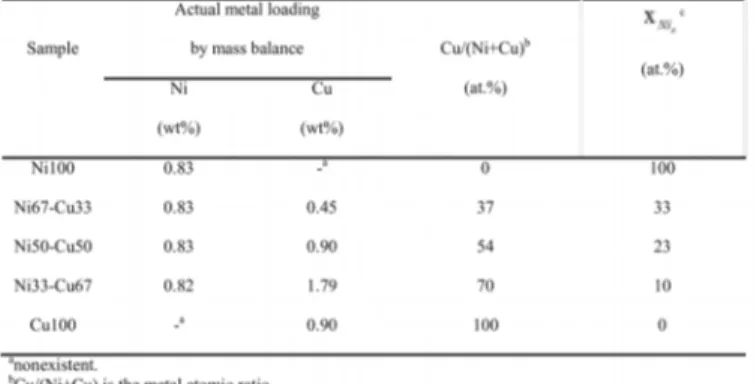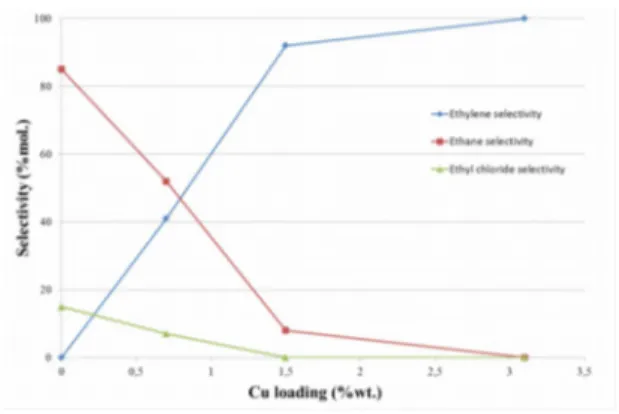BIOENCAPSULATION INNOVATIONS : Encapsulation of
nanoparticles for catalysis applications
Stéphanie D. Lambert, University of Liege, Laboratory of Chemical Engineering –
Nanomaterials, Catalysis, Electrochemistry, B-4000 Liege, Belgium
NI-CU/SIO
2COGELLED
XEROGEL CATALYSTS FOR
SELECTIVE
HYDRODECHLORINATION OF
1,2-DICHLOROETHANE INTO
ETHYLENE
There is an increasing demand for technology that will convert chlorocarbons as by-products of industrial processes into more useful or environmentally benign products. For example, hydrodechlorination of chlorinated organics is a particularly attractive alternative compared with incineration of wastes from the chlorine industry from both economic and environmental points of view (Kalnes, 1988). Several authors demonstrated the ability of bimetallic catalysts, composed of metals from Groups VIII and IB, to convert chlorinated alkanes selectively into less or not chlorinated alkenes. Here it is presented catalytic activity and selectivities of 1,2-dichloroethane hydrodechlorination over Ni-Cu/SiO2 cogelled
xerogel catalysts and the relationships between catalytic activity and surface properties of bimetallic catalysts. To understand the mechanism of hydrodechlorination of 1,2-dichloroethane on a supported alloy, the surface composition of Ni-Cu alloy is measured from H2 chemisorption, XRD and
TEM.
Experimental
Samples containing various amounts of nickel and copper are xerogels prepared by a one-step sol-gel procedure, which consists in the cogelation of the silica precursor, tetraethoxysilane (TEOS), with organically substituted alkoxides capable of forming chelates with nickel and copper ions (Lambert, 2008). All the reagents are with industrial grade. The resulting alcogels were dried under vacuum at 80°C, calcined in air at 400°C, and finally reduced in hydrogen at 450°C. All samples were tested for 1,2-dichloroethane hydrodechlorination. For each catalytic experiment, 0.11 g of catalyst pellets, sieved between 250 and 500 µm, were tested. The total flow of the reactant mixture was 0.45 mmol s-1 and consisted of CH
2Cl-CH2Cl
(0.011 mmol s-1), H
2 (0.023 mmol s-1), and He (0.42 mmol s-1).
The temperature was successively kept at 200, 250, 300, 350 and 300°C. The effluent was analyzed every 15 min.
The combination of results from H2 chemisorption,
XRD and TEM allowed calculating the surface composition of the nickel-copper particles in all cogelled xerogel catalysts. Values obtained indicate a very pronounced surface enrichment with copper (Lambert, .
Table 1. Actual metal loading and surface composition of Ni-Cu nanoparticles in cogelled xerogel catalysts.
Results and discussion
Textural curves were obtained from nitrogen adsorption-desorption isotherms and mercury porosimetry measurements. All the samples are characterized by a narrow micropore size distribution around 0.8 nm inside SiO2
particles, a broad porous distribution between 2 and several hundred nm outside SiO2 particles and cumulated volumes
equal from 1 to 7 cm3/g (comparable to aerogels) (Figure 1)
(Lambert, 2006).
Figure 1 : Pore size distributions of samples Ni100 (
¿
), Ni67-Cu33 (♦), Ni50-Cu50 (▲), Ni33-Cu67 (●)and Cu100 (■).
The cogelation synthesis procedure described in this study allows obtaining highly dispersed Ni-Cu/SiO2 cogelled xerogel
catalysts. These samples contain Ni-Cu alloy crystallites with sizes of 1.6-3.4 nm, and which are located inside microporous silica particles (Figure 2).
Figure 2 : On the right, scheme of a microporous silica particle (grey) with a Ni-Cu nanoparticle in the center (yellow); on the left, TEM micrograph of Ni33-Cu67 sample (350.000 ×).
The combination of results from the calculation of H2
chemisorption, XRD measurements and transmission electron microscopy allowed calculating the surface composition of the nickel-copper particles in Ni-Cu/SiO2 cogelled xerogel
catalysts. Values obtained indicate a very pronounced surface enrichment with copper. The copper concentration, which is higher at the surface in comparison with the bulk of the alloy, results from a surface energy of copper, which is slightly lower than the surface energy of nickel. Furthermore, the surface enrichment with Cu could result from a preferential localization of Cu atoms on low coordination sites. (Table 1). While 1,2-dichloroethane hydrodechlorination over pure nickel mainly produces ethane, increasing copper content in bimetallic catalysts results in an increase in ethylene selectivity (Figures 3 and 4). Used alone, copper deactivates rapidly due to its covering by chlorine atoms. Thanks to its activation power of hydrogen by dissociative chemisorption, nickel present in the Ni-Cu alloy supplies hydrogen atoms for the regeneration of the chlorinated copper surfaces into metallic copper.
Figure 3: 1,2-dichloroethane hydrodechlorination for sample Ni50-Cu50. (●) ClCH2-CH2Cl conversion, ( ¿ )
C2H4 selectivity, (□) C2H6 selectivity, (Δ) C2H5Cl
selectivity, (—) Temperature.
The specific consumption rate of 1,2-dichloroethane decreases when copper loading increases. The turnover frequency, that is, the number of catalytic cycle per active site (nickel atom and its surrounding copper atoms) and per second, seems to be independent of surface composition of alloy particles.
Figure 4: C2H4, C2H6 and C2H5Cl selectivities as a
function of copper loading.
Conclusions
The ultimate aim of this study was to prepare with a very simplified synthesis procedure and industrial grade reagents, highly dispersed Ni-Cu/SiO2 catalysts. Furthermore, these
catalysts had to be very active and selective for 1,2-dichloroethane hydrodechlorination into ethylene. This aim is reached because these bimetallic catalysts product only ethylene during catalytic tests of 75 hours without deactivation. Furthermore, the chemicals purity seems to have no influence on textural properties and catalytic performances of Ni-Cu/SiO2 cogelled xerogel catalysts. So the
use of industrial reagents is encouraging for the follow of the study concerning the extrapolating of the synthesis of metallic cogelled catalysts to an industrial scale.
REFERENCES
T. N. Kalnes, R. B. James, Environ. Prog., 7 (1988) 185. S. Lambert, K. Y. Tran, G. Arrachart, F. Noville, C. Henrist, C. Bied, J. J. E. Moreau, M. Wong Chi Man, B. Heinrichs, Microporous Mesoporous Mater., 115 (2008) 609.
S. Lambert, B. Heinrichs, A. Brasseur, A. Rulmont, J.-P. Pirard, Appl. Catal. A, 270 (2004) 201.
S. Lambert, F. Ferauche, B. Heinrichs, N. Tcherkassova, J.-P. Pirard, C. Alié, J. Non-Cryst. Solids, 352 (2006) 2751.
FIRST AUTHOR SUMMARY
Pr. Stéphanie D. Lambert, University of Liege, Laboratory of Chemical Engineering – Nanomaterials, Catalysis, Electrochemistry, Allée de la Chimie 3, B6a, B-4000 Liège. She received the M.Sc. in Chemical Engineering from the University of Liege in 1999 and Ph.D. in Applied Sciences in the same university in 2003. She worked as a researcher engineer at Nanocyl Society in 2004. In 2005, she joined the Department of Chemical Engineering of the University of Illinois at Chicago. From 2009, she became permanent as an Associate Professor and a FRS-FNRS Research Associate in the University of Liege.

